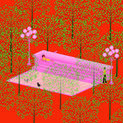
The Campus Collections include dozens of sculptures, paintings, monuments, and memorials important to the University’s rich history and its singular traditions. One segment of the Campus Collections, the Princeton Portraits, is a collection of more than 600 paintings and sculptures, predominantly likenesses of important Princetonians as well as non-portrait works that relate to the history of the University. The Princeton Portraits span centuries and encompass enormously varying styles and subjects, including Charles Willson Peale’s landmark portrait of George Washington at the Battle of Princeton (1783), commissioned with funds given by Washington himself. Other highlights include a remarkable sequence of dinosaur paintings by the Victorian artist and naturalist Benjamin Waterhouse Hawkins, commissioned in 1876 by then University President James McCosh as a progressive response to Darwin’s theories.
Perhaps the most celebrated works in the Campus Collections belong to the John B. Putnam Jr. Memorial Collection of outdoor sculpture, distributed across the University campus. Comprising 22 sculptures by master artists of the 20th and 21st centuries, the Putnam Collection is the result of a generous gift of funds in the 1960s by an anonymous donor as a memorial to a Princeton alumnus killed in World War II. Commonly regarded as one of the greatest single collections of public art, the Putnam Collection can be thought of as a plein-air lesson in art history by many of the great masters of the modern canon. Highlights include Sir Henry Moore’s cast bronze organic abstraction Oval with Points (1969–70), thought to have been inspired by the undulating surface of an elephant skull given to the artist by the distinguished scientist Sir Julian Huxley, and Alexander Calder’s steel stabile Five Disks: One Empty (1969–70). The work was painted in Princeton’s collegiate colors of orange and black when installed, but the orange disks were blackened after Calder saw his piece on-site, evidently with some displeasure—orange did not routinely figure as part of the artist’s palette. The Putnam Collection is not a static phenomenon, and work is underway to identify and purchase or commission works by artists who can be considered the masters of our own time, so that the collection continues to reflect the evolution of artistic practices.





